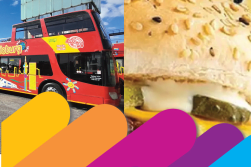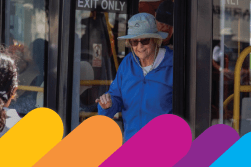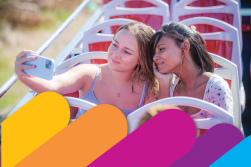City Sightseeing Soweto Township Tour
12 June 2015 | Carina van Wyk
The Soweto tour is a fun extension of the Joburg Red Bus City Tour
As soon as you hop onto City Sightseeing’s bright red taxi, you’re not only going to “SoWeToo”; you’re also given a “SoWeToo-an” name.
Phiwe Khumalo, our guide, named me Queen Thembi while my fellow passengers included a Queen Leratho, Gugu and Neo, and a King Thabo and Mandla (a French guy who soon started calling himself King Mandela).
City Sightseeing’s red taxi shortly before its departure to Soweto, Joburg’s largest and most vibrant township
The first stop was FNB Stadium (known as Soccer City during the 2010 FIFA World Cup), the biggest stadium in Africa, built in the form of a calabash, or Zulu clay pot, traditionally used for serving umqombothi (beer). This is where thousands of people from all over the world gathered for the opening and closing matches of the 2010 FIFA World Cup.
From there, driver Thabo Masebe took us to Diepkloof; we drove past the Baragwanath taxi rank and hospital, and stopped at the brightly coloured Orlando Towers. According to Phiwe, approximately 25 000 litres of paint were used to turn these decommissioned cooling towers into the piece of artwork they are today. Our timing was perfect: as the red taxi came to a standstill we saw a person – to us a tiny dot in the air – bungee jump from the platform between the two towers.
FNB Stadium, also known as Soccer City
“Do you know why we live in Soweto … why I live in Soweto? Because I love living in Soweto,” said Phiwe as we headed to the Hector Pieterson Museum.
We soon hopped off and volunteer guide Sibusiso Mhlanga shared with us Hector’s tragic story – how he was killed when police opened fire on protesting students on 16 June 1976. Students were protesting against, among other things, the introduction of Afrikaans as a language of instruction in township schools.
The plaque at the Hector Pieterson Museum. It was unveiled by Nelson Mandela in 1992
Volunteer guide Sibusiso Mhlanga telling a group of tourists about the student protest on 16 June 1976
The well-known image of a dying Hector Pieterson being carried by a fellow student, with his petrified sister running next to them. It was taken by news photographer Sam Nzima
Our next stop was the vibrant Vilakazi Street, the only street in the world that has been home to two Nobel Prize winners – Nelson Mandela and Desmond Tutu.
It’s in this street, with several restaurants, that “you eat until you crawl on your stomach” – a promise Phiwe made to a hungry Australian tourist earlier on the tour. The stalls lining the street, where colourful handmade arts and crafts are sold, add to the bustling atmosphere.
Vibrant Vilakazi Street
Rafael Ferrao and Ivana Arezina from Edenvale pose for a picture in front of Mandela House
Colourful arts, crafts and jewellery
Unique sandals for sale
As we drove through the busy streets of Kliptown on the last stretch of the tour, Vitor Ferrao from Edenvale said: “It’s quite enlightening. I do believe South Africans should do this tour … locals should do it. How do you get the spirit ofubuntu if you don’t come here?”
Phiwe smiled, as if his job was done, and said: “You can come to South Africa, but if you haven’t been to Soweto you haven’t been to South Africa.”
While heading back to the Apartheid Museum , Phiwe told each “King” and “Queen” what his or her name meant – giving us all a quick language lesson. I couldn’t help being impressed with the name he chose for me: Thembi, derived from the Zulu word, thembekile, which means trustworthy.
“Thanks for joining us, Queen Thembi.” – City Sightseeing guide Phiwe Khumalo
The Soweto tour, which is an extension of the Joburg Red City Tour, departs from stop 13 at the Apartheid Museum every hour from 11.15am to 3.15pm. The trip through Soweto takes two hours, but if you join one of the earlier tours, you have the option of spending a bit more time at the Hector Pieterson Museum or in Vilakazi Street.
Find out more here.



